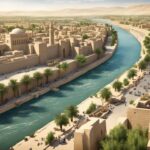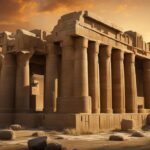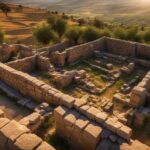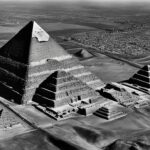Nineveh, an ancient city located in Mesopotamia, was once the capital of the powerful Assyrian civilization. Known for its archaeological ruins, Nineveh is a significant historical site that played a crucial role in the history of the ancient Near East. Filled with captivating stories and fascinating facts, this ancient city holds the key to unraveling the mysteries of the past.
Key Takeaways:
- Nineveh was an ancient city in Mesopotamia and the capital of the Assyrian civilization.
- It is known for its archaeological ruins and is a significant historical site.
- Nineveh holds great biblical importance, mentioned in stories of Jonah and King Sennacherib.
- In biblical times, Nineveh was a majestic city with grand palaces, citadels, and beautiful gardens.
- The city witnessed major biblical events, such as the story of Jonah and the attack on the Kingdom of Judah.
- Today, visitors can explore the ancient ruins of Nineveh and witness the architectural prowess of the Assyrian civilization.
The Biblical Importance of Nineveh
Nineveh, the biblical city, holds great significance in religious and historical narratives. It was founded by Ashur and served as the capital of the mighty Assyrian Empire. The city’s biblical importance is evident through its association with notable biblical figures, such as the prophet Jonah and King Sennacherib.
In the Book of Jonah, Nineveh is depicted as a city in need of repentance. The reluctant prophet Jonah was sent by God to warn the people of Nineveh about their impending destruction. This story emphasizes the importance of obedience to God and the potential for redemption.
“Arise, go to Nineveh, that great city, and call out against it, for their evil has come up before me.” – Jonah 1:2
Another significant biblical figure linked to Nineveh is King Sennacherib. He ruled over Nineveh during the zenith of the Assyrian Empire and is famously known for his attack on the Kingdom of Judah. The biblical account of his siege on Jerusalem showcases the military might and power of Nineveh during that time.
| Biblical Figure | Significance |
|---|---|
| Jonah | Prophesied against Nineveh |
| King Sennacherib | Ruled over Nineveh, attacked Kingdom of Judah |
The biblical accounts of Nineveh illustrate its prominent role in both religious and political contexts. The city’s significance extends beyond its historical ruins, making it a captivating destination for those interested in exploring the ancient world and biblical history.
The Historical Significance of Nineveh
In biblical times, Nineveh was a majestic city known for its grandeur and architectural marvels. The city had mighty citadels, grand palaces, beautiful gardens, and even zoos. It was a cultural and political center of the Assyrian Empire and played a crucial role in several major biblical events. The city’s history is intertwined with the rise and fall of the Assyrian Empire, leaving behind a rich legacy for future generations to explore.
One notable event in Nineveh’s history is the story of Jonah and the whale. According to the Bible, Jonah was sent by God to warn the people of Nineveh about their impending destruction. His message of repentance resonated with the Ninevites, who heeded the warning and turned away from their sinful ways. This event is a testament to the city’s significance in biblical narratives and the power of religious proclamation.
Furthermore, Nineveh is closely associated with King Sennacherib, a prominent figure in biblical history. King Sennacherib ruled over Nineveh during the height of the Assyrian Empire and launched a military campaign against the Kingdom of Judah. The siege of Jerusalem and the subsequent events that unfolded marked a turning point in the region’s history and showcased Nineveh’s military might and political influence.
The historical significance of Nineveh cannot be overstated. Its grandeur, biblical events, and role in the Assyrian Empire make it an invaluable site for understanding the ancient world. Today, visitors can explore the archaeological ruins of Nineveh and marvel at the remnants of its once-glorious past, gaining insight into the culture, customs, and achievements of the Assyrian civilization.
The Major Biblical Events in Nineveh
Nineveh is not only an ancient city of immense historical and archaeological significance but also a place deeply intertwined with biblical events. The city’s prominence in the Bible and its connection to notable biblical figures add another layer of fascination to its rich history.
Jonah and the Whale
“Now the word of the Lord came to Jonah the son of Amittai, saying, ‘Arise, go to Nineveh, that great city, and cry out against it; for their wickedness has come up before Me.'” – Jonah 1:1-2
One of the most famous stories associated with Nineveh is that of Jonah and the whale. According to the biblical account, God sent the prophet Jonah to warn the people of Nineveh about their impending destruction due to their wickedness. After initially trying to escape his divine mission, Jonah eventually arrived in Nineveh and delivered his message of repentance. The people of Nineveh heeded Jonah’s warning, leading to their salvation and the city’s redemption in the eyes of God.
Sennacherib’s Attack on Judah
“Then Sennacherib king of Assyria came and entered Judah; he encamped against the fortified cities, thinking to win them over to himself.” – 2 Chronicles 32:1
Nineveh also played a significant role in the biblical account of King Sennacherib’s attack on the Kingdom of Judah. Sennacherib, the ruler of the mighty Assyrian Empire, set his sights on conquering Jerusalem, the capital of Judah. The biblical narrative describes how Sennacherib’s forces besieged the city but ultimately retreated after a miraculous intervention by God, sparing Jerusalem from destruction.
The Impact on Nineveh’s History
These major biblical events had a profound impact on Nineveh’s history and its portrayal in ancient texts. The story of Jonah and the salvation of Nineveh showcases the city’s potential for repentance and redemption. Additionally, Sennacherib’s failed attack on Jerusalem demonstrated the limits of the Assyrian Empire’s power, highlighting the resilience of smaller kingdoms in the face of overwhelming odds.
| Biblical Event | Key Takeaways |
|---|---|
| Jonah and the Whale | The salvation of Nineveh through repentance. |
| Sennacherib’s Attack on Judah | The failed attempt to conquer Jerusalem and the limits of Assyrian power. |
These biblical events not only shaped the narrative surrounding Nineveh but also influenced the city’s historical development and its significance in religious and political contexts.
The Ancient Ruins of Nineveh
Located in Mesopotamia, the ancient city of Nineveh boasts remarkable archaeological ruins that offer a glimpse into the grandeur of the Assyrian civilization. These ruins, spread across an expansive historical site, allow visitors to immerse themselves in the rich history and architectural marvels that once defined Nineveh.
The remnants of Nineveh’s grand structures, including walls, palaces, and temples, stand as a testament to the city’s ancient glory. Visitors can admire the intricate craftsmanship and engineering achievements that were characteristic of the Assyrian civilization. The archaeological site of Nineveh is a captivating destination for history enthusiasts and anyone seeking to connect with the past.
The archaeological ruins of Nineveh transport visitors back in time, allowing them to witness the architectural prowess and cultural significance of this ancient city. It is truly a remarkable experience to explore the remains of a civilization that once thrived in this very location.
The Magnificence of Nineveh’s Architecture
The architectural wonders of Nineveh are truly awe-inspiring. One of the notable structures within the archaeological ruins is the grand palace of King Sennacherib. This magnificent complex featured lavish courtyards, majestic halls, and intricately decorated rooms, showcasing the wealth and power of the Assyrian Empire.
Additionally, the city of Nineveh was renowned for its advanced hydraulic engineering. The ancient Assyrians constructed an elaborate system of canals and aqueducts to supply water to the city and its gardens. These gardens were considered some of the most beautiful in the ancient world, often compared to the legendary Hanging Gardens of Babylon.
| Architectural Marvels of Nineveh | Description |
|---|---|
| King Sennacherib’s Palace | A grand palace complex with lavish courtyards, halls, and decorated rooms. |
| Hydraulic Engineering | An advanced system of canals and aqueducts that supplied water to the city and its gardens. |
| The Hanging Gardens of Nineveh | Beautiful gardens that rivaled the legendary Hanging Gardens of Babylon. |
The architectural achievements of Nineveh continue to fascinate historians and archaeologists, shedding light on the rich cultural heritage of the Assyrian civilization. These ancient ruins serve as a poignant reminder of the ingenuity and creativity of our ancestors, leaving an indelible mark on the historical landscape.
The Legacy of Nineveh
The ancient city of Nineveh holds a remarkable legacy that extends far beyond its physical remains. As one of the most important historical sites of the Assyrian civilization, Nineveh’s influence can still be felt in various aspects of ancient architecture, art, and cultural practices.
The architectural achievements of Nineveh, such as the famed Hanging Gardens of Babylon, have left a lasting impact on later civilizations. The city’s innovative designs and engineering marvels continue to inspire awe and admiration, showcasing the advanced skills of the Assyrians.
“Nineveh’s architecture reflects the grandeur and power of the Assyrian Empire. Its monumental citadels, palaces, and temples speak volumes about the sophistication and wealth of this ancient civilization.” – Dr. Emma Thompson, Archaeologist
Exploring the ancient ruins of Nineveh allows us to witness the ingenuity of the Assyrians firsthand. The careful preservation of these archaeological sites has provided valuable insights into the customs, traditions, and daily lives of the people who inhabited this ancient city.
Today, Nineveh continues to captivate historians, archaeologists, and enthusiasts alike. Its legacy serves as a bridge between our present and the ancient world, reminding us of the rich tapestry of history that shaped our current civilization.
Key Characteristics of Nineveh’s Ancient Architecture
To truly grasp the significance of Nineveh’s architectural legacy, it is essential to understand the key characteristics that define this ancient city’s structures:
- Monumental Scale: Nineveh’s buildings were designed to impress, with massive dimensions that showcased the city’s power and wealth.
- Precision Engineering: The Assyrians demonstrated remarkable engineering skills, employing advanced techniques in their construction projects.
- Elaborate Relief Sculptures: Richly decorated reliefs adorned the walls of Nineveh’s palaces, depicting scenes from religious, mythological, and everyday life.
- Innovative Building Materials: The Assyrians used a combination of mud bricks, limestone, and alabaster to construct their buildings, creating a diverse and visually striking architectural landscape.
These architectural characteristics ensure that the legacy of Nineveh endures, inviting us to marvel at the accomplishments of the ancient Assyrian civilization.
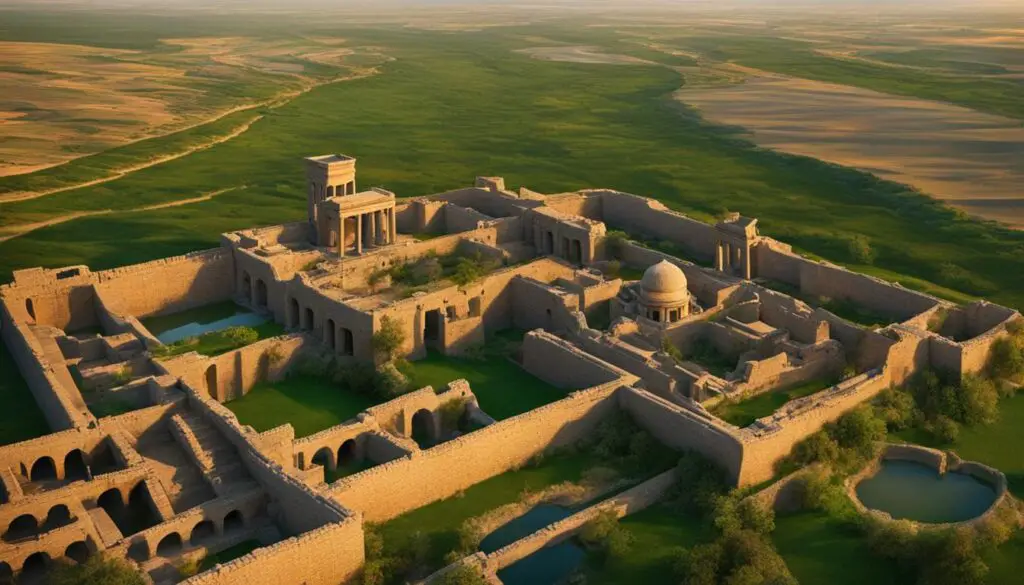
King Sennacherib and Nineveh
King Sennacherib, an influential ruler of the Assyrian Empire, left a lasting impact on the history of Nineveh. Known for his military campaigns, Sennacherib’s reign marked a period of prosperity and expansion for the ancient city. One of the notable events associated with Sennacherib and Nineveh is his attack on the Kingdom of Judah, as described in the Old Testament.
According to biblical accounts, Sennacherib sought to conquer Jerusalem, but his campaign was unsuccessful due to divine intervention. This event, often referred to as the Siege of Jerusalem, holds significant historical and religious importance. It not only shaped the course of Nineveh’s history but also had a profound impact on the Kingdom of Judah and the surrounding regions.
Archaeological excavations in Nineveh provide valuable insights into Sennacherib’s reign and his contributions to the city’s development. The remains of grand structures, including palaces and fortifications, showcase the architectural achievements of the time. These excavations continue to uncover artifacts and evidence that shed light on the political and cultural landscape during Sennacherib’s rule and offer a deeper understanding of ancient Assyrian civilization.
The Reign of King Sennacherib
During his reign, King Sennacherib transformed Nineveh into a thriving capital, solidifying its status as a monumental city of the ancient world. The city boasted impressive infrastructure, including a sophisticated water system, extensive gardens, and a labyrinth of interconnected palaces and temples. Sennacherib’s ambition and vision for Nineveh are evident in the grandeur that remains in the archaeological record.
Despite his military conquests and architectural achievements, Sennacherib’s rule was not without challenges. The biblical accounts also mention his assassination by his own sons, which marked the end of his reign. However, his legacy in Nineveh and the impact of his rule are still subjects of study and fascination.
| Events | Impact on Nineveh |
|---|---|
| Attack on the Kingdom of Judah | Highlighted Nineveh’s military might and territorial expansion |
| Construction of grand palaces and fortifications | Transformed Nineveh into a symbol of power and grandeur |
| Assassination by his own sons | Marked the end of Sennacherib’s reign and triggered a period of political instability |
Rediscovery and Preservation of Nineveh
After centuries of being lost to history, Nineveh has been rediscovered through archaeological excavations and the decipherment of cuneiform inscriptions. These efforts have allowed researchers to piece together the city’s history and preserve its cultural heritage. The ongoing preservation projects ensure that the ancient ruins and artifacts found in Nineveh continue to be studied and appreciated by future generations.
The archaeological excavations in Nineveh have revealed invaluable insights into the Assyrian civilization and its achievements. The excavations have unearthed intricate architectural structures, detailed sculptures, and a wealth of ancient artifacts. These findings have not only shed light on the city’s past glory but also provided a deeper understanding of the daily life and culture of the Assyrian people.
Given the historical significance of Nineveh, preserving its remains is of utmost importance. The delicate process of preservation involves meticulous documentation, protection from natural elements, and structural stabilization. The aim is to safeguard the archaeological treasures and ensure that they can be enjoyed by future generations, providing a window into the grandeur of the ancient Assyrian civilization.
Efforts to preserve Nineveh also extend to education and public engagement initiatives. Museums and educational institutions around the world showcase the artifacts from Nineveh, allowing people to learn about the city’s history and appreciate its cultural heritage. Through exhibitions, lectures, and interactive displays, the legacy of Nineveh continues to captivate audiences and inspire further exploration into the ancient world.
Table: Notable Artifacts Unearthed in Nineveh
| Artifact | Description |
|---|---|
| Assyrian Lamassu | A majestic winged lion or bull with a human head, guarding the entrances of palaces and temples. |
| Library of Ashurbanipal | A vast collection of clay tablets inscribed with cuneiform script, providing valuable insights into ancient literature, science, and history. |
| Ivory Carvings | Exquisite ivory carvings depicting mythical creatures, royal hunts, and scenes from daily life. |
| Royal Inscriptions | Stone inscriptions documenting the achievements, conquests, and royal decrees of the Assyrian kings. |
The Modern Significance of Nineveh
Today, Nineveh holds immense cultural and historical significance. As a UNESCO World Heritage site, it attracts visitors from around the world who come to explore the ancient ruins and learn about the rich history of the Assyrian civilization. The study of Nineveh continues to contribute to our understanding of the ancient world and the civilizations that existed before us.
Nineveh’s historical site serves as a reminder of humanity’s shared cultural heritage. It offers a unique opportunity to witness the grandeur of an ancient city that once stood as a testament to the power and influence of the Assyrian Empire. Visitors can immerse themselves in the past, walking through the remains of majestic palaces, marveling at the intricate carvings and craftsmanship that have withstood the test of time.
The cultural significance of Nineveh is not limited to its ancient ruins alone. It extends to the countless artifacts and treasures unearthed through archaeological excavations. These artifacts provide valuable insights into the daily lives, beliefs, and achievements of the people who called Nineveh their home. They help paint a vivid picture of the past and deepen our understanding of the Assyrian civilization.
Table: Notable biblical figures associated with Nineveh
| Biblical Figure | Significance |
|---|---|
| Jonah | Sent by God to prophesy against Nineveh and warn of its impending destruction |
| King Sennacherib | Ruled over Nineveh during the time of the Assyrian Empire and played a prominent role in biblical events |
Furthermore, Nineveh’s cultural heritage goes beyond its physical remnants. It has inspired artists, writers, and scholars throughout history, shaping literature, architecture, and the understanding of ancient civilizations. The city’s story continues to be told through various mediums, ensuring that its legacy lives on and inspires future generations.
Today, as we explore the ancient ruins, stand in awe of the architectural marvels, and delve into the stories that unfolded within its walls, we are reminded of the enduring power of history. Nineveh stands as a testament to the remarkable achievements of the Assyrian civilization and the importance of preserving our shared heritage.
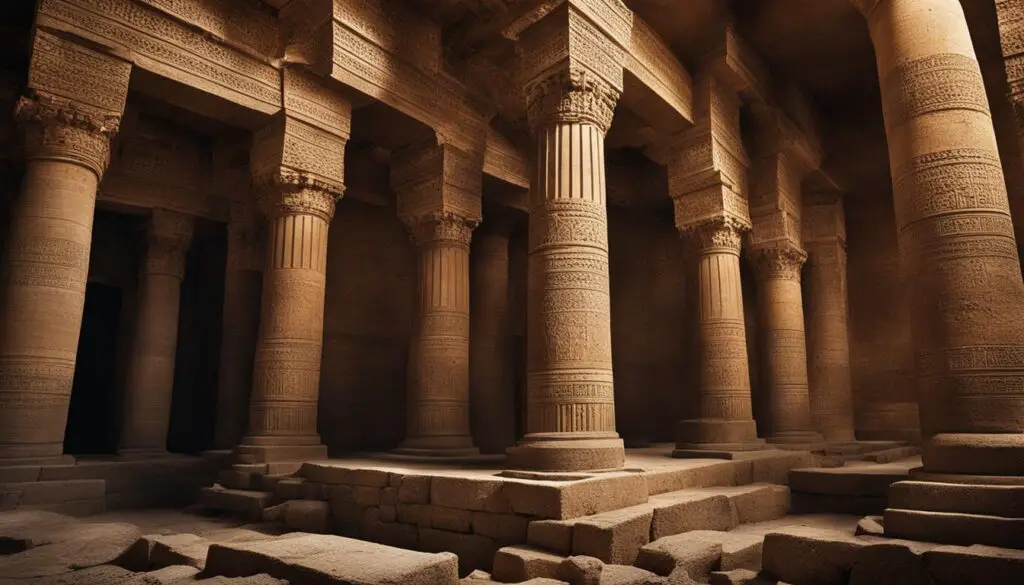
Conclusion
Nineveh, the ancient city nestled in Mesopotamia, holds immense historical and biblical significance. As the capital of the Assyrian Empire, it played a pivotal role in shaping the course of ancient history. Its archaeological ruins and architectural marvels offer a window into the past, allowing us to uncover the secrets of the Assyrian civilization.
In biblical narratives, Nineveh emerges as a prominent city, intertwined with notable biblical figures. The prophet Jonah’s mission to warn the city of its impending destruction and King Sennacherib’s attack on the Kingdom of Judah are among the major biblical events associated with Nineveh. These events left a lasting impact on the city’s history and portrayal in ancient texts.
During biblical times, Nineveh stood as a majestic city, renowned for its grandeur and architectural prowess. Magnificent citadels, palaces, gardens, and zoos characterized its landscape. As the cultural and political center of the Assyrian Empire, it served as a hub of power and influence.
Today, Nineveh’s ancient ruins continue to captivate visitors from around the world. The remnants of its grand structures, including walls, palaces, and temples, showcase the remarkable craftsmanship and engineering achievements of the Assyrian civilization. The preservation and study of Nineveh’s cultural heritage contribute to our understanding of the ancient world and its civilizations.
FAQ
What is the significance of Nineveh in history?
Nineveh is an ancient city that served as the capital of the powerful Assyrian civilization. It played a crucial role in the history of the ancient Near East and is known for its archaeological ruins and captivating stories.
How is Nineveh mentioned in the Bible?
Nineveh is mentioned in the Bible as the city founded by Ashur and the capital of the Assyrian Empire. It is associated with biblical figures like Jonah, who was sent to prophesy against the city, and King Sennacherib, who ruled over Nineveh during the time of the Assyrian Empire.
What are some major biblical events associated with Nineveh?
Nineveh witnessed several major biblical events, including the story of Jonah and the whale, where the prophet was sent to warn the people of Nineveh. It is also associated with King Sennacherib’s attack on the Kingdom of Judah, as described in the Old Testament.
What can visitors see at the ruins of Nineveh today?
The archaeological ruins of Nineveh offer a glimpse into the city’s grandeur, including walls, palaces, and temples. Visitors can appreciate the ancient craftsmanship and engineering achievements that defined Nineveh’s architecture.
How has the legacy of Nineveh influenced later civilizations?
Nineveh’s architectural achievements, such as the Hanging Gardens of Babylon, have left a lasting impact on later civilizations. Its influence can be seen in ancient architecture, art, and cultural practices of the time.
Who was King Sennacherib and what role did he play in Nineveh’s history?
King Sennacherib was a renowned ruler of the Assyrian Empire who played a significant role in the history of Nineveh. He was known for his military campaigns, including the attack on the Kingdom of Judah and the subsequent siege of Jerusalem.
How was Nineveh rediscovered and preserved?
Nineveh was rediscovered through archaeological excavations and the decipherment of cuneiform inscriptions. Ongoing preservation projects ensure that the ancient ruins and artifacts found in Nineveh continue to be studied and appreciated.
What is the modern significance of Nineveh?
Today, Nineveh is a UNESCO World Heritage site, attracting visitors from around the world who come to explore its ancient ruins and learn about the rich history of the Assyrian civilization. The study of Nineveh contributes to our understanding of the ancient world and the civilizations that came before us.

